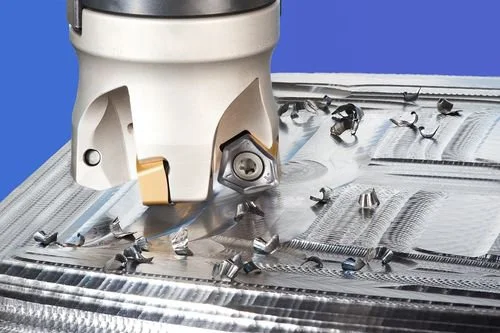In CNC milling, down milling or up milling?
In CNC machining, the rotation direction of the milling cutter generally remains unchanged, but the feed direction changes. There are two common phenomena in milling processing: down milling and up milling.
The cutting edge of a milling cutter is subjected to impact loads every time it makes a cut. For successful milling, the correct contact between the cutting edge and the material must be considered as the cutting edge enters and exits during a cut. In the milling process, the workpiece is fed in the same or opposite direction as the direction of rotation of the milling cutter, which affects the cut-in and cut-out of the milling and whether the down milling or up milling method is used.
01 The golden rule of milling—from thick to thin
When milling, it is important to consider chip formation. The decisive factor in chip formation is the position of the milling cutter. Always strive to form thick chips when the cutting edge cuts in and thin chips when the cutting edge cuts out to ensure a stable milling process. Remember the golden rule of milling, “thick to thin,” to ensure that the blade comes out with as little chip thickness as possible.
02 Down milling
In climb milling, the cutting tool is fed in the direction of rotation. Climb milling is always the preferred method as long as the machine tool, fixture and workpiece allow it.
In edge down milling, the chip thickness will gradually decrease from the beginning of the cut and eventually reach zero at the end of the cut. This prevents the cutting edge from scratching and rubbing against the part surface before engaging in cutting.
Large chip thickness is advantageous and cutting forces tend to pull the workpiece into the mill, keeping the cutting edge cutting. However, because milling cutters tend to be pulled into the workpiece, the machine tool needs to deal with table feed clearance by eliminating backlash. If the milling cutter is pulled into the workpiece, the feed will increase unexpectedly, potentially causing excessive chip thickness and cutting edge cracks. In these cases, consider up milling.
03 Up milling
In up milling, the cutting tool feeds in the opposite direction to its direction of rotation.
The chip thickness gradually increases from zero until the end of the cutting. The cutting edge must be forced in, creating a scratched or polished effect due to friction, heat and constant contact with the work-hardened surface created by the preceding cutting edge. This all reduces tool life.
The thick chips and higher temperatures produced by the cutting edge will cause high tensile stresses, which will shorten the tool life and the cutting edge will often be damaged quickly. It can also cause chips to stick or weld to the cutting edge, which then carries them to the starting position of the next cut, or cause the cutting edge to momentarily chip.
Cutting forces tend to push the milling cutter and workpiece away from each other, while radial forces tend to lift the workpiece off the table.
When there are large changes in machining allowance, up milling may be advantageous. When using ceramic inserts to process high-temperature alloys, it is also recommended to use up milling, because ceramics are more sensitive to the impact caused when cutting into the workpiece.
04 Workpiece fixture
The feed direction of the tool places different requirements on the workpiece fixture. It should be able to resist lifting forces during up milling. It should be able to resist downforce during down milling.




